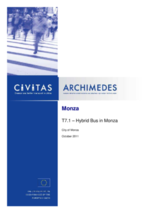Introduction of hybrid buses
Summary
To develop a fleet of easily accessible vehicles that meets the highest standards of energy efficiency, Ghent will replace its high floor trolleybuses with 20 energy-efficient and innovative articulated hybrid buses.
Implementing sustainable mobility
Transport company De Lijn will introduce the articulated hybrid buses as a transitional measure between the present old high-floor trolleybuses and the future tramcars foreseen on a part of present trolley line. The city wants to increase its experience with articulated hybrid buses so it can make an informed decision when buying more buses. There are several advantages to hybrid buses, such as the fact that they recuperate braking energy towards energy storage equipment such as super capacitors or batteries, which is used again while accelerating. As a result, the diesel motor can be smaller than the classic articulated diesel buses. This ‘downsizing’ reduces the weight of the engine from approximately 1000 kg to around 450 kg.
Moreover, the diesel motor can run over a narrow and optimal number of revolutions per minute range, close to its peak efficiency. The torque curve of the hybrid-bus engine is therefore tailored to frequent steady-state operation, for optimal emissions performance and fuel efficiency. The diesel engine-generator can be sound-insulated better than classic diesel buses, and is much quieter.
Progress
 After an in-depth analysis of the specifications required to fulfil the objectives in De Lijn’s energy and quality policy, a call for tender was launched. In this call, a test phase was foreseen for the offered vehicles of the interested suppliers. One vehicle served as a test case during the spring of 2009. The test case proved to be very successful and 18 more hybrid buses have been introduced into the Ghent public transport network.
After an in-depth analysis of the specifications required to fulfil the objectives in De Lijn’s energy and quality policy, a call for tender was launched. In this call, a test phase was foreseen for the offered vehicles of the interested suppliers. One vehicle served as a test case during the spring of 2009. The test case proved to be very successful and 18 more hybrid buses have been introduced into the Ghent public transport network.
In total De Lijn introduced 20 new energy-efficient and innovative articulated low floor hybrid buses (type AG300H) on busline 3.
Outcomes
- Reduction of 17,2% on fuel costs
During the year 2011, De Lijn saved with its 20 hybrid buses, all driving on line 3, 112.118 EUR. The reduction of fuel use leads to a reduction of 17,2% of fuel costs per year per hybrid bus compared to a standard articulated bus.
- Fuel use reduced with 16,3%
During the period of 1/01/2011 till 31/05/2012, the average fuel consumption of a hybrid bus is 47,51 l/100 km while the average fuel consumption of a standard articulated bus is 56,73 l/100km. The fuel consumption is reduced with 9,2 l/100km, or 16,3%. The quantifiable target of reduction with 25% is substantially achieved (at least 50%). This is partially caused by the fact that in the winter period the difference of fuel consumption between hybrid and standard articulated buses is less than in the summer period.
- Emission reduced with 17%
Comparing emssions produced by hybrid and standard articulated buses leads to a reduction of 17,2% per year. This means a reduction of 271,55 tons of CO2, 1.726 kg NOx and 18 kg PM per year.
- Acceptance of hybrid buses
57% of PT users was aware that they were travelling on a hybrid bus, 65% of the PT users even prefer travelling on a hybrid one.









